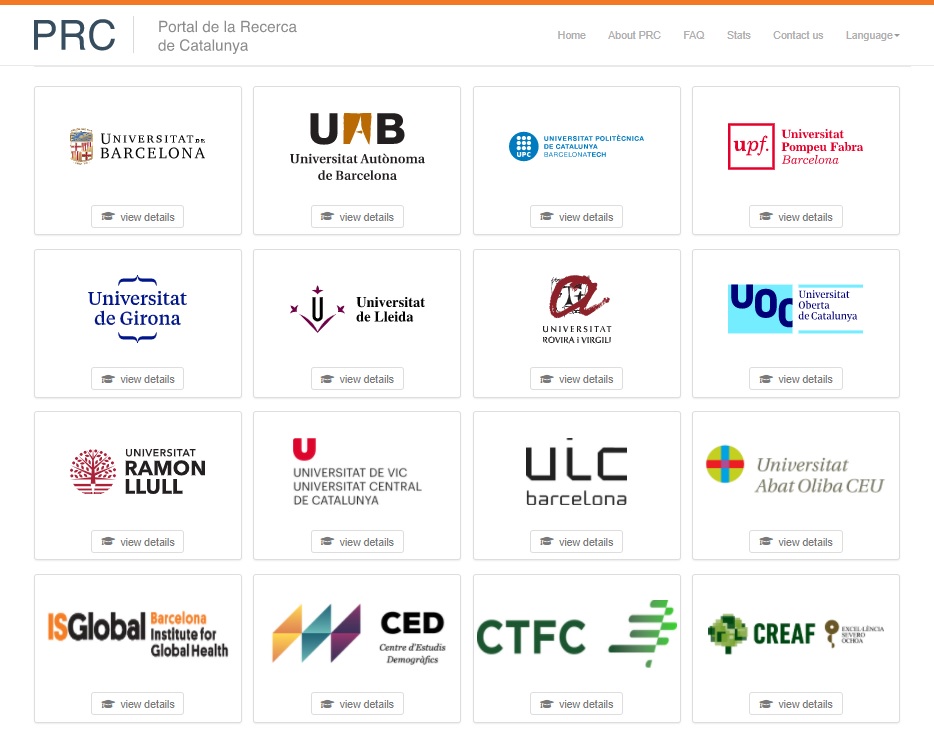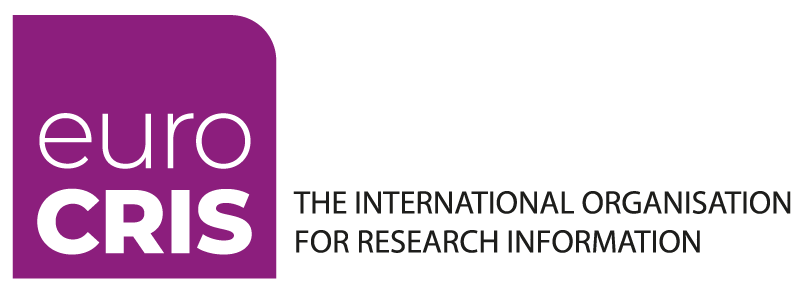This conversation with the team behind the Research Portal of Catalonia (PRC) is the first one in a series of interviews we will be holding with euroCRIS members in the forthcoming months. These interviews aim to keep the information exchange going at a time where the impossibility of holding in-person events makes it harder to follow the ongoing developments.
«Competition seems to prevail over cooperation»
The relevance of Open Access and of publicly displaying the research outputs produced by Catalan universities and research centres or in the whole country prompted the Generalitat de Catalunya to launch the Portal de la Recerca de Catalunya (PRC). The coordination of the project was assumed by the Catalan Consortium of University Services (Consorci de Serveis Universitaris de Catalunya, CSUC) together with a working commission made of experts from member Catalan universities and research centres. The first steps of the project were taken at the end of 2012, and the PRC Research Portal was opened to the public in 2016 after a restricted access period.
The portal's goal is to display and disseminate from a single place the research activity that is carried out in Catalonia regarding researchers, publications, research groups and research projects. This information is provided for the international scientific community, companies, financial organisations and the general public, thus making Open Access to scientific outputs easy. In the long term, the project aims at simplifying management processes as well as to support their evaluation.
12 universities and 39 research centres are currently participating in the Research Portal, which reports on nearly 650,000 publications authored by over 17,000 researchers.

The PRC team during an online coordination call: Lluís Anglada (left), Ricard de la Vega and Sandra Reoyo
1. The PRC has significantly grown in the last few years, expanding well beyond public universities and onto research centres in Catalonia. Could you describe the advocacy process for persuading a growing number of institutions to join the initiative?
The PRC took its first steps in 2012 as a possible project. From that moment on, it has experienced three different phases: the construction of the portal, the incorporation of information from universities into the portal and, finally, the extension to research centres. Adding universities was a relatively easy process as they all had CRIS systems and research support staff who shared the goal of creating this portal. Doing this, we were also improving the information of the CRIS themselves. Nevertheless, we had to work hard to adapt CRIS systems, which were non-CERIF-compliant, to start exporting with this format.
Including research centres was a more difficult task for several reasons: they were larger (in number), they did not have working CRIS systems in general, and participating in the Portal meant an extra effort for which they did not have any resources. In the first place, we gave clear and individual explanations to each centre about the objectives of having and being part of a Research Portal. Secondly, we let CRIS providers know the importance of having a CERIF output, as we did with universities too. In that sense, we offered them several tools to support and validate the format, and an excel-CERIF gateway for those centres that did not have a CRIS system. Finally, for the rest of the centres we made a complex information extraction from WoS and Scopus that we later uploaded to the PRC.
Participation in the PRC is voluntary, but the Government of Catalonia has clearly expressed the benefits of having a single portal through which everyone could consult all the research done in Catalonia at any time. In addition to the government’s commitment, emulation has also played a role as no university or centre would want to stay out if others were in.
2. The University CRIS systems are quite different from the systems used at research centres and hospitals – even if some companies did develop CRIS systems for these organisations. Are there any plans to integrate the research information in these systems into the PRC? And how interoperable are these systems compared to the CRIS solutions used at publicly funded universities in Catalonia?
That is true. There are important differences between universities and research centres. Universities are larger and more multi-purpose than research centres, which influences their possibilities and needs. Catalan universities generally use their own CRIS systems or work with large, well-established systems. When we first started working with research centres, those using CRIS systems were a minority, but this situation has completely changed over the last few years. Nowadays, most research centres have commercial systems or are in the process of doing so.
It is also true that the systems used by research centres – Fontventa, Fundanet and iMarina – are different from those of universities and are perhaps less oriented to the economic management of research, and instead more focused on exploitation of results and comparison with other centres.
Either way, we followed the same principles that we did when working with universities: we proposed them to implement the CERIF international standard to promote content interoperability and, therefore, the participation in the Portal. We also provided them with support and tools to validate the format. We believe that companies have seen that this improvement in their software made them more competitive.
3. Do you feel any specific difference in the approach towards Open Science at universities vs research centres/institutes?
There are differences and similarities. The resemblance relies on the fact that the research community is in favour of transparency and openness to science, promoting more and better science. The difference might be that universities are more multi-purpose than centres and, especially, that universities are expanding the library functions to facilitate the “opening” of science, whereas in research centres the availability of this resource is much smaller.
4. What about Open Innovation? Research centres could perhaps be expected to fare particularly well in this area since they're less inclined to devote their efforts to making their research outputs openly available.
The PRC has always been viewed as a potential portal for facilitating innovation, but the transition from research to innovation is neither easy nor automatic. In recent years, research done in Catalonia and Spain has improved significantly, but improvements in innovation have not increased proportionally.
We would like the Portal to be used for innovation, but the conventional provision of information certainly does not help. The Portal should be enriched with taxonomies and ontologies to allow a more flexible and comprehensive navigation and visualisation of the information.
In recent years, in Europe several data integration projects have been released in the research field to create instruments to facilitate innovation and bring research closer to the society that funds this research. Here we would like to cite CRIStin (Norway), the Danish National Research Database (Denmark), FRIS (Belgium-Flanders), NARCIS (The Netherlands), SwePub (Sweden), GtR (United Kingdom) and Research.fi (Finland).
We believe that both the mentioned portals and the PRC can easily evolve towards research valorisation and dissemination systems, platforms for the identification of expertise and knowledge transfer support, or the monitoring and accountability of research.
5. Some research portals include not only publications but also projects and research data and have information exchange strategies that cover from machine-to-machine XML to Excel files. Does the PRC provide a similar degree of flexibility to its participant institutions?
Up until now, only publications and conference speeches were considered research outputs, but open science is widening that vision and emphasising the re-use of research and the social impact of science. That will make research portals expand their content, but this ultimately depends on the information they receive from the CRIS. Research data repositories are still in an early stage, and although some portals do include them, this has not yet become the norm. The PRC plans to do it soon.
In a similar way, the information will increasingly be read by machines and it will be necessary to prepare this information to be easily read. At the end of 2020, the PRC was able to offer its information in open data, something that was possible thanks to the use of two APIs. The predefined content API allows the total or partial download of the portal’s content via predefined calls. On the other hand, there is an API that allows the download of dataset aggregation of historical contents integrated in the open data portal from the Catalan Government. Some institutions from Catalonia are already using PRC’s data through either of these two systems.
6. Have other regional consortia in Spain expressed any interest in replicating the PRC initiative even if their number of universities and research institutes may be smaller?
Yes, at least the Autonomous Communities of Madrid (Madroño Consortium) and Castilla y León (Bucle) are creating similar portals.
7. Is contributing to an improved Open Access implementation in Catalonia a specific goal of the PRC, or is this rather a task for the partnering institutions?
Both things. One of the initial goals of the PRC was to promote Open Access, but, as it is well known, this is a complex goal that is being pursued in multiple ways. The PRC does two very important actions pro OA. One is to provide whenever is possible a link to Open Access versions (favoring the location of versions in repositories and through the automatic detection of open versions offered by the Unpaywall tool). The second is to maintain an indicator of Open Access publications that uses the same methodology as the NARCIS portal. Currently, a 28% of the publications between 2012 and 2018 and available through the Portal are Open Access.
At the same time, universities are promoting Open Access with self-archiving mandates, maintaining repositories, and facilitating the deposit. Some of these activities are jointly monitored by a working group coordinated by CSUC’s Open Science Area. The Conference of Rectors of Spanish Universities (CRUE) currently has a working group that is negotiating some journal subscription contracts so that these include the publication of Open Access articles by researchers from Spanish universities without implying a cost to the researcher or an overcharge to the system.
8. At some point a strategy was under consideration for some institutions in Catalonia to implement the same CRIS solution. Do you think the PRC has ended up being a better and more affordable option thanks to its flexibility in terms of information exchange mechanisms?
The PRC wants to be an information aggregator about the research done by multiple entities with different instruments, but it does not have the intention to be a CRIS. The PRC has helped to see the information about research in a different way. For a very long time, this information was considered an internal element of the institution, but portals like the PRC show that the information about research results has an outward function.
Open Science means a paradigm shift, and the new landscape must be a set of federated and interconnected infrastructures and services. To make this ecosystem possible, interoperability is essential, which is the ability for different systems, with different functions, to talk to and feed each other. At the time of renewing the CRIS system of some universities, the adoption of a single CRIS system for some institutions was studied. The initiative did not succeed, but even if it had, it would not have covered the entire system, a goal that the PRC does achieve through the use of information exchange standards.
This interoperability is not only achieved with computers and algorithms, but we also need common protocols (such as CERIF), identifiers and communication agreements. The PRC, with all its limitations – which are many – has shown to the Catalan system that with a relatively low effort we can create common platforms to improve the global scenario.
9. What were the principal challenges and opportunities in the process of creating the PRC?
We will mention two of each.
The PRC has been made possible thanks to the use of standards and a professional team. The first challenge that we considered when creating the portal was how to know that two people were the same or two articles were the same. Identifiers such as ORCID and DOI, but also interoperability protocols and the decision to use CERIF as an import standard have greatly facilitated the work. In second place, we have had the collaboration of different professionals – mostly librarians – who manage information in universities and research centers, and were convinced that improving the information management would affect and benefit everyone.
We can also list a couple of difficulties. The first one is the environment of competition that is everywhere and that also affects scientific communication. Competition seems to prevail over cooperation, and together with a strong institutional corporate culture, institutions push for the creation of portals and services of institutional nature much more than cooperative ones. We think that the PRC has shown that these two things are not only compatible, but also mutually supportive. The second one is a certain technological optimism between politicians and senior managers that makes them think that anything is possible and that is possible to do it easily. There is a lot of work and a lot of people behind the PRC, and there is a wide range of agreements that allow to do things that cannot be done only with technology.

Universities and research centres taking part in the PRC initiative (click on the image for a full list)


